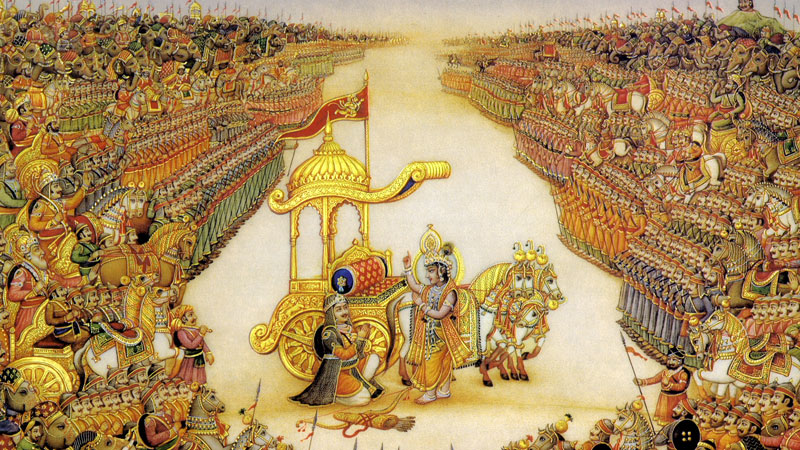
Symbolism is an essential part of any viable spiritual tradition, and Indian spiritual lore is heavily symbolic, so much so that many begin to treat everything about it as a symbol.
Christianity inherited this both from India and from Jewish philosophers such as Philo to whom just about everything was symbolic. Origen refused to consider the Gospels as literal historical accounts and at one place in his writings mentions what a great difficulty the Christian encounters if he believes that Jesus rode into Jerusalem seated on a donkey. He does not explain what the difficulty would be and I have never known anyone who could even guess at his meaning. (Perhaps because his statement is so patently silly.)
For us who are sitting with Arjuna listening to Krishna’s revelation, the Gita must be seen as both literal and symbolic–simultaneously. If we arbitrarily decide when the Gita is literal and when it is symbolic we will not only cut our understanding of its message by half, we will also confuse ourselves. It is also very necessary that we apply the Gita’s statements to the physical, mental, and spiritual (higher mental, actually) levels of our life. Otherwise we will miss many applications of its wisdom.
Why not you?
I would like to pause here for a serious statement. It is gratifying to me that you are reading my ideas on the meaning of the Bhagavad Gita. However it is my hope that you will read many commentaries on the Gita–those of past generations as well as the contemporary ones. This is because the Gita is as infinite as the Consciousness that speaks through it. Therefore a single human being cannot possibly encompass all the meanings of the Gita. Nor can the commentaries of several do so, either. So keep on reading!
You, too, need to study the Gita directly and gain your own insights. Jesus said that “every scribe which is instructed unto the kingdom of heaven is like unto a man that is an householder, which bringeth forth out of his treasure things new and old” (Matthew 13:52).
The wisdom of the past is still wisdom, and the wisdom of the present is equally wise. Both are needed. The word kainos here translated “new” also has the connotation of freshness, the idea being that new insights can continue to be brought forth–and why not by you?
Mental viewpoint
Now having said all this about literal and symbolic I would like to analyze the next few verses from the psychological angle since it is the mind-intellect which influences both the physical and the spiritual life. As Sri Ramakrishna often observed: “The mind is everything.”
The war
Anyone who wishes to better himself in any way faces the necessity of effort–even struggle. The “war” of the Bhagavad Gita takes place internally, is a spiritual struggle to the death of ignorance and the ascendance of illumination. Many never engage in the war, frightened away by the prospect of the sacrifice and strife. Those engaged in the spiritual war often would like to avoid it or mitigate it or somehow work out a “cease-fire.” They commit themselves to sure defeat by such a wish if they follow it through.
We, however, wish to succeed, to win the war, so let us listen to what Krishna tells us as we, too, quail before the prospects of battle.
It is our duty and our nature
“And, perceiving your own caste duty, you should not tremble. Indeed anything superior to righteous battle does not exist for the kshatriya” (2:31).
I plan to wait until the fourth chapter, where Krishna tells us that God is the originator of the four castes, to go into the subject in any depth, so here I want only want to point out that although Sargeant and others may use the expression “caste duty” in translating this verse, the actual Sanskrit says swadharma, which is something far different. That, too, is best saved for an in-depth essay later on, but right now it must be made clear that swadharma means “self dharma,” the action which is in perfect accordance with our present state of evolution–which may be spoken about in terms of caste.
Yet, the higher meaning is the dharma of the Self, the action that will best lead to the knowledge of our eternal being. So the purpose of this verse is to show that the inner struggle for enlightenment is twofold: a duty and an expression/manifestation of our true nature.
Since people are usually out of touch with who they really are, another kind of appeal is needed, and duty/responsibility is the most frequently and reasonably invoked. On the other hand, the spiritual struggle is our duty because it is our nature to ascend, to evolve. So they really are the same thing in the context of the Gita.
Further Reading:
Grow your spiritual Library:
The Bhagavad Gita for Awakening: A Practical Commentary for Leading a Successful Spiritual Life, available in print and as an ebook from Amazon and other online bookstores. Learn both the literal and symbolic meanings.







